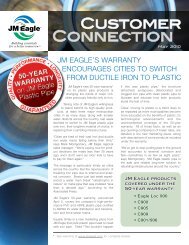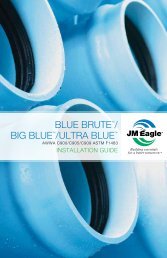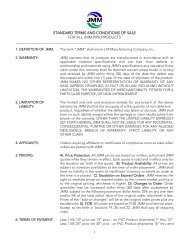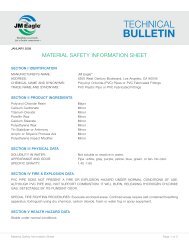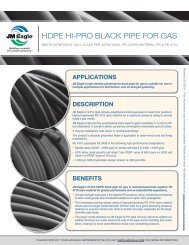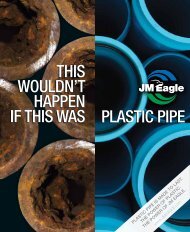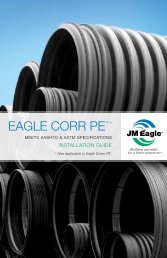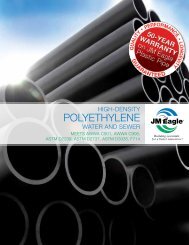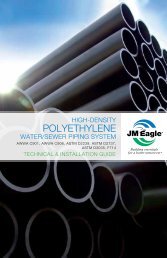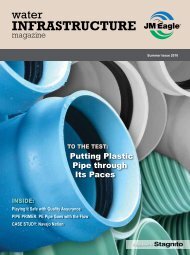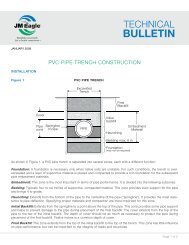I.P.S. Pressure/Irrigation (P.I.P) Installation Guide - JM Eagle
I.P.S. Pressure/Irrigation (P.I.P) Installation Guide - JM Eagle
I.P.S. Pressure/Irrigation (P.I.P) Installation Guide - JM Eagle
Create successful ePaper yourself
Turn your PDF publications into a flip-book with our unique Google optimized e-Paper software.
5.1.1 Deflection Testing<br />
It is the position of <strong>JM</strong> <strong>Eagle</strong> that deflection testing of PVC pipe is unnecessary<br />
when pipe is installed in accordance with the acceptable practices<br />
stated in this guide. Most towns and municipalities limit initial deflection to 5<br />
percent, when in actuality ASTM D3034 recommends PVC pipe deflection<br />
7.5 percent of base inside diameter. Thus, exceeding these limits does not<br />
necessarily indicate any structural damage, failure or reduction in life and<br />
only add to the cost of the project. Proof of this position is that more than<br />
750 million feet of PVC sewer pipe are performing satisfactorily in the field<br />
today. On the other hand, where improper installation practices are known or<br />
suspected, questionable bedding materials are employed, and/or installation<br />
conditions are severe, deflection testing of these sections of the installation<br />
should be considered advisable by the engineer. In the event that deflection<br />
measurement is a requirement, please consult <strong>JM</strong> <strong>Eagle</strong> Publication <strong>JM</strong>E-<br />
05B, “Gravity Sewer <strong>Installation</strong> <strong>Guide</strong>.”<br />
5.2 Testing Water Pipe<br />
It is good practice to pressure test portions of a line as it is installed—before<br />
the entire line is completed. Before testing, all parts of the line should be<br />
backfilled and braced sufficiently to prevent movement under pressure. (See<br />
Figure 19.)<br />
In setting up a section of line for test, a provision for air relief valves should<br />
be made.<br />
There are three parts of the line to consider when testing:<br />
1. The run of pipe, which must be backfilled sufficiently to prevent movement<br />
under test pressure.<br />
2. Thrust blocks at fittings, which should be permanent and constructed<br />
to withstand test pressure. If concrete thrust blocks are used, enough<br />
time to permit the cement to set must elapse before testing.<br />
3. Test ends, which should be capped and braced to withstand the appreciable<br />
thrusts that are developed under test pressure. Refer to<br />
Section 3.9 on “Thrust Blocking and Anchorage at Fittings.”<br />
IRRIGATION & I.P.S. PRESSURE INSTALLATION GUIDE<br />
37



